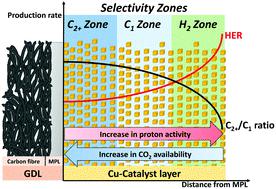当前位置:
X-MOL 学术
›
Energy Environ. Sci.
›
论文详情
Our official English website, www.x-mol.net, welcomes your feedback! (Note: you will need to create a separate account there.)
The product selectivity zones in gas diffusion electrodes during the electrocatalytic reduction of CO2
Energy & Environmental Science ( IF 32.5 ) Pub Date : 2021-10-13 , DOI: 10.1039/d1ee01696b Tim Möller 1 , Trung Ngo Thanh 1 , Xingli Wang 1 , Wen Ju 1 , Zarko Jovanov 1 , Peter Strasser 1
Energy & Environmental Science ( IF 32.5 ) Pub Date : 2021-10-13 , DOI: 10.1039/d1ee01696b Tim Möller 1 , Trung Ngo Thanh 1 , Xingli Wang 1 , Wen Ju 1 , Zarko Jovanov 1 , Peter Strasser 1
Affiliation

|
Here we report on the most prominent factors influencing the performance of a Cu-based CO2 electrolyzer operating at high currents. Using a flow-electrolyzer design where CO2 gas feed passes directly through the electrode interacting with the Cu catalyst layer, we observed that the selectivity of the electrochemical CO2 reduction in (bulk) pH neutral media can greatly be influenced by adjusting the structure of the electrode. In this, the variations in catalyst loading and ionomer content can profoundly affect the selectivity of CO2RR. We explore the hypothesis that this originates from the overall mass transport variations within the porous catalytic layer of the gas diffusion electrode. As further evidence for this, apart from the CO2 electrolysis results, we propose a special method to benchmark the reactant mass transport in flow-cells using oxygen reduction reaction (ORR) limiting current measurements. Our analysis suggests that a restriction of mass transport is highly desirable due to its connection to a local alkalization and corresponding suppression of pH-dependent reaction products, given the absence of local CO2 concentration limitations. We further show how the electrode structure can be used to push the observed catalytic CO2 reduction selectivity either towards C1 or C2+ products, dependent on the ionomer content and catalyst loading in a cathodic current range of 50 to 700 mA cm−2. Measurements at various KHCO3 electrolyte concentrations agree with the notion of the local pH dictating the overall selectivity and point towards the presence of pronounced concentration gradients within the system. Overall, our work suggests that the differences in electrocatalytic CO2 reduction selectivity at high currents (in a range of pH neutral buffering electrolytes) largely originate from the local concentration gradients defined by the initial catalyst ink formulation and architecture of the catalytic layer, both of which represent a powerful tool for optimization in the production of selected value-added products.
中文翻译:

CO2电催化还原过程中气体扩散电极中的产物选择性区
在这里,我们报告了影响在高电流下运行的基于铜的 CO 2电解槽性能的最重要因素。使用流动电解槽设计,其中 CO 2气体进料直接通过电极与 Cu 催化剂层相互作用,我们观察到在(本体)pH 中性介质中电化学 CO 2还原的选择性可以通过调整电极。在这种情况下,催化剂负载和离聚物含量的变化会深刻影响 CO 2的选择性RR。我们探索了这样的假设,即这源于气体扩散电极多孔催化层内的整体传质变化。作为对此的进一步证据,除了 CO 2电解结果之外,我们还提出了一种特殊方法来使用氧还原反应 (ORR) 限制电流测量对流通池中的反应物质量传输进行基准测试。我们的分析表明,由于不存在局部 CO 2浓度限制,因此非常需要限制质量传输,因为它与局部碱化和 pH 依赖性反应产物的相应抑制有关。我们进一步展示了如何使用电极结构将观察到的催化 CO 2还原选择性推向 C1或 C 2+产物,取决于离聚物含量和在 50 至 700 mA cm -2阴极电流范围内的催化剂负载。在各种 KHCO 3电解质浓度下的测量与局部 pH 值决定整体选择性的概念一致,并表明系统内存在明显的浓度梯度。总的来说,我们的工作表明电催化 CO 2的差异 高电流下的还原选择性(在一定范围的 pH 中性缓冲电解质中)主要源于由初始催化剂油墨配方和催化层结构定义的局部浓度梯度,这两者都代表了优化所选生产的有力工具增值产品。
更新日期:2021-10-13
中文翻译:

CO2电催化还原过程中气体扩散电极中的产物选择性区
在这里,我们报告了影响在高电流下运行的基于铜的 CO 2电解槽性能的最重要因素。使用流动电解槽设计,其中 CO 2气体进料直接通过电极与 Cu 催化剂层相互作用,我们观察到在(本体)pH 中性介质中电化学 CO 2还原的选择性可以通过调整电极。在这种情况下,催化剂负载和离聚物含量的变化会深刻影响 CO 2的选择性RR。我们探索了这样的假设,即这源于气体扩散电极多孔催化层内的整体传质变化。作为对此的进一步证据,除了 CO 2电解结果之外,我们还提出了一种特殊方法来使用氧还原反应 (ORR) 限制电流测量对流通池中的反应物质量传输进行基准测试。我们的分析表明,由于不存在局部 CO 2浓度限制,因此非常需要限制质量传输,因为它与局部碱化和 pH 依赖性反应产物的相应抑制有关。我们进一步展示了如何使用电极结构将观察到的催化 CO 2还原选择性推向 C1或 C 2+产物,取决于离聚物含量和在 50 至 700 mA cm -2阴极电流范围内的催化剂负载。在各种 KHCO 3电解质浓度下的测量与局部 pH 值决定整体选择性的概念一致,并表明系统内存在明显的浓度梯度。总的来说,我们的工作表明电催化 CO 2的差异 高电流下的还原选择性(在一定范围的 pH 中性缓冲电解质中)主要源于由初始催化剂油墨配方和催化层结构定义的局部浓度梯度,这两者都代表了优化所选生产的有力工具增值产品。


























 京公网安备 11010802027423号
京公网安备 11010802027423号